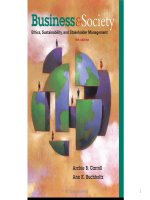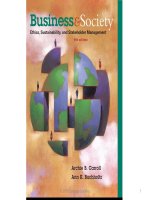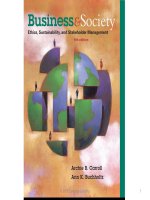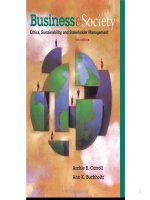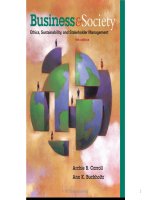Operation management 9e stevenson mcgrwhill chap007
Bạn đang xem bản rút gọn của tài liệu. Xem và tải ngay bản đầy đủ của tài liệu tại đây (384.68 KB, 32 trang )
7
Design of
Work Systems
McGraw-Hill/Irwin
Copyright © 2007 by The McGraw-Hill Companies, Inc. All
Learning Objectives
Explain the importance of work design.
Briefly describe the two basic approaches to job
design.
Discuss the advantages and disadvantages of
specialization.
Explain the term knowledge-based pay.
Explain the purpose of methods analysis and
describe how methods studies are performed.
Describe four commonly used techniques for
motion study.
7-2
Learning Objectives
Discuss the impact of working conditions on job
design.
Define a standard time.
Describe and compare time study methods and
perform calculations.
Describe work sampling and perform calculations.
Compare stopwatch time study and work
sampling.
Contrast time and output pay systems.
7-3
Job Design
Job design involves specifying the content
and methods of job
What will be done
Who will do the job
How the job will bob will be done
Where the job will be done
Ergonomics: Incorporation of human factors
in the design of the workplace
7-4
Design of Work Systems
Specialization
Behavioral Approaches to Job Design
Teams
Methods Analysis
Motions Study
Working conditions
7-5
Job Design Success
Successful Job Design must be:
Carried out by experienced personnel with
the necessary training and background
Consistent with the goals of the
organization
In written form
Understood and agreed to by both
management and employees
7-6
Specialization in Business: Advantages
Table 7.1
For Management:
For Labor:
1. Simplifies training 1. Low education and
2. High productivity
3. Low wage costs
skill requirements
2. Minimum
responsibilities
3. Little mental effort
needed
7-7
Disadvantages
Table 7.1
For Management:
For Labor:
1. Difficult to motivate
quality
1. Monotonous work
2. Limited opportunities
for advancement
2. Worker dissatisfaction,
possibly resulting in
3. Little control over work
absenteeism, high
4. Little opportunity for
turnover, disruptive
self-fulfillment
tactics, poor attention
to quality
7-8
Behavioral Approaches to Job
Design
Job Enlargement
Giving a worker a larger portion of the total
task by horizontal loading
Job Rotation
Workers periodically exchange jobs
Job Enrichment
Increasing responsibility for planning and
coordination tasks, by vertical loading
7-9
Motivation and Trust
Motivation
Influences quality and productivity
Contributes to work environment
Trust
Influences productivity and employeemanagement relations
7-10
Teams
Benefits of teams
Higher quality
Higher productivity
Greater worker satisfaction
Self-directed teams
Groups of empowered to make certain
changes in their work process
7-11
Methods Analysis
Methods analysis
Analyzing how a job gets done
Begins with overall analysis
Moves to specific details
7-12
Methods Analysis
The need for methods analysis can come
from a number of different sources:
Changes in tools and equipment
Changes in product design
or new products
Changes in materials or procedures
Other factors (e.g. accidents, quality problems)
7-13
Methods Analysis Procedure
1. Identify the operation to be studied
2. Get employee input
3. Study and document current method
4. Analyze the job
5. Propose new methods
6. Install new methods
7. Follow-up to ensure improvements
have been achieved
7-14
Selecting an Operation
Selecting a job to study consider:
High labor content
Done frequently
Unsafe
Tiring
Unpleasant
Noisy
Designated problem
7-15
Analyzing the Job
Flow process chart
Chart used to examine the overall
sequence of an operation by focusing on
movements of the operator or flow of
materials
Worker-machine chart
Chart used to determine portions of a
work cycle during which an operator and
equipment are busy or idle
7-16
rage
S to
me
nt
Ins
pe c
t io n
Del
ay
Details of Method
Mo
ve
ANALYST PAGE
Job Requisition of petty cash D. Kolb 1 of 2
n
FLOW PROCESS CHART
Op
era
ti o
Figure 7-2
Requisition made by department head
Put in “pick-up” basket
To accounting department
Account and signature verified
Amount approved by treasurer
Amount counted by cashier
Amount recorded by bookkeeper
Petty cash sealed in envelope
Petty cash carried to department
Petty cash checked against requisition
Receipt signed
Petty cash stored in safety box
7-17
Motion Study
Motion study is the systematic
study of the human motions used
to perform an operation.
7-18
Motion Study Techniques
Motion study principles - guidelines for
designing motion-efficient work procedures
Analysis of therbligs - basic elemental
motions into which a job can be broken down
Micromotion study - use of motion pictures
and slow motion to study motions that
otherwise would be too rapid to analyze
Charts
Therbligs
7-19
Developing Work Methods
1.
2.
3.
4.
5.
Eliminate unnecessary motions
Combine activities
Reduce fatigue
Improve the arrangement of the workplace
Improve the design of tools and equipment
7-20
Therbligs
Therbligs: Basic elemental motions that make up a
job.
Search
Select
Grasp
Hold
Transport load
Release load
7-21
Working Conditions
T e m p e ra tu re &
H u m id it y
I llu m in a t io n
V e n t ila t io n
C o lo r
7-22
Working Conditions (cont’d)
Noise & Vibration
Work Breaks
Safety
Causes of Accidents
7-23
Work Measurement
Work measurement: Determining how long it
should take to do a job.
Standard time
Stopwatch time study
Historical times
Predetermined data
Work Sampling
7-24
Standard time
Standard time:
The amount of time it should take a qualified
worker to complete a specific task, working at a
sustainable rate, using given methods, tools and
equipment, raw materials, and workplace
arrangement.
7-25
